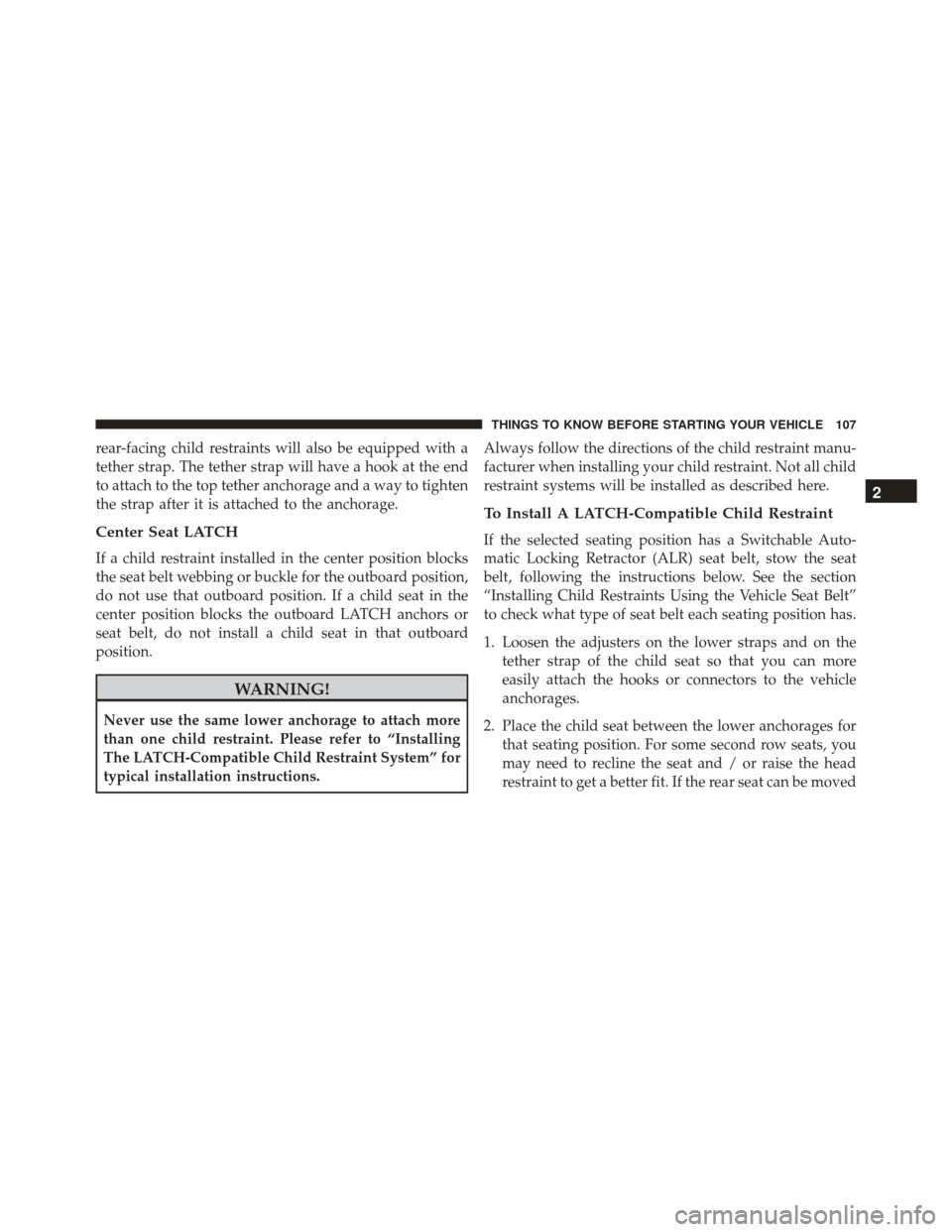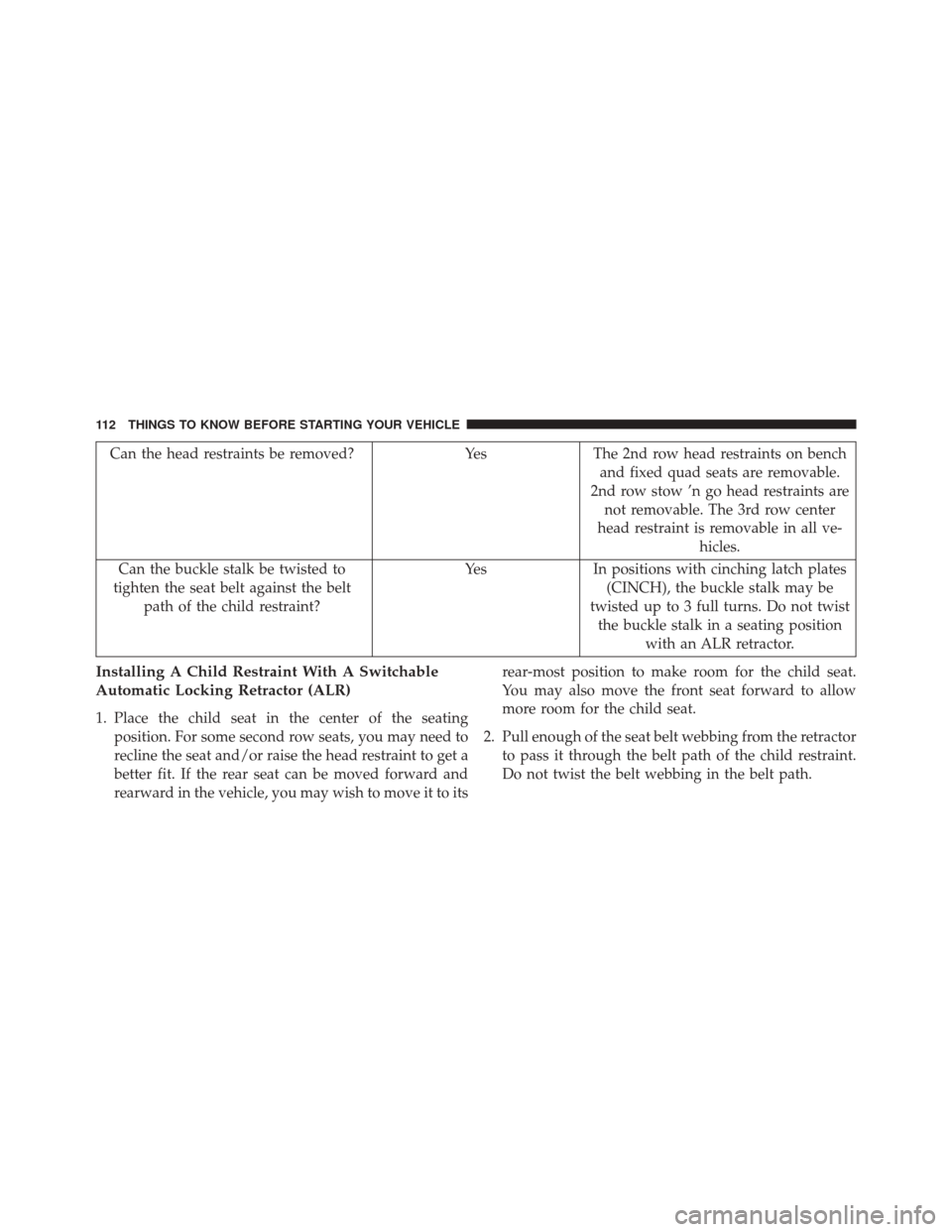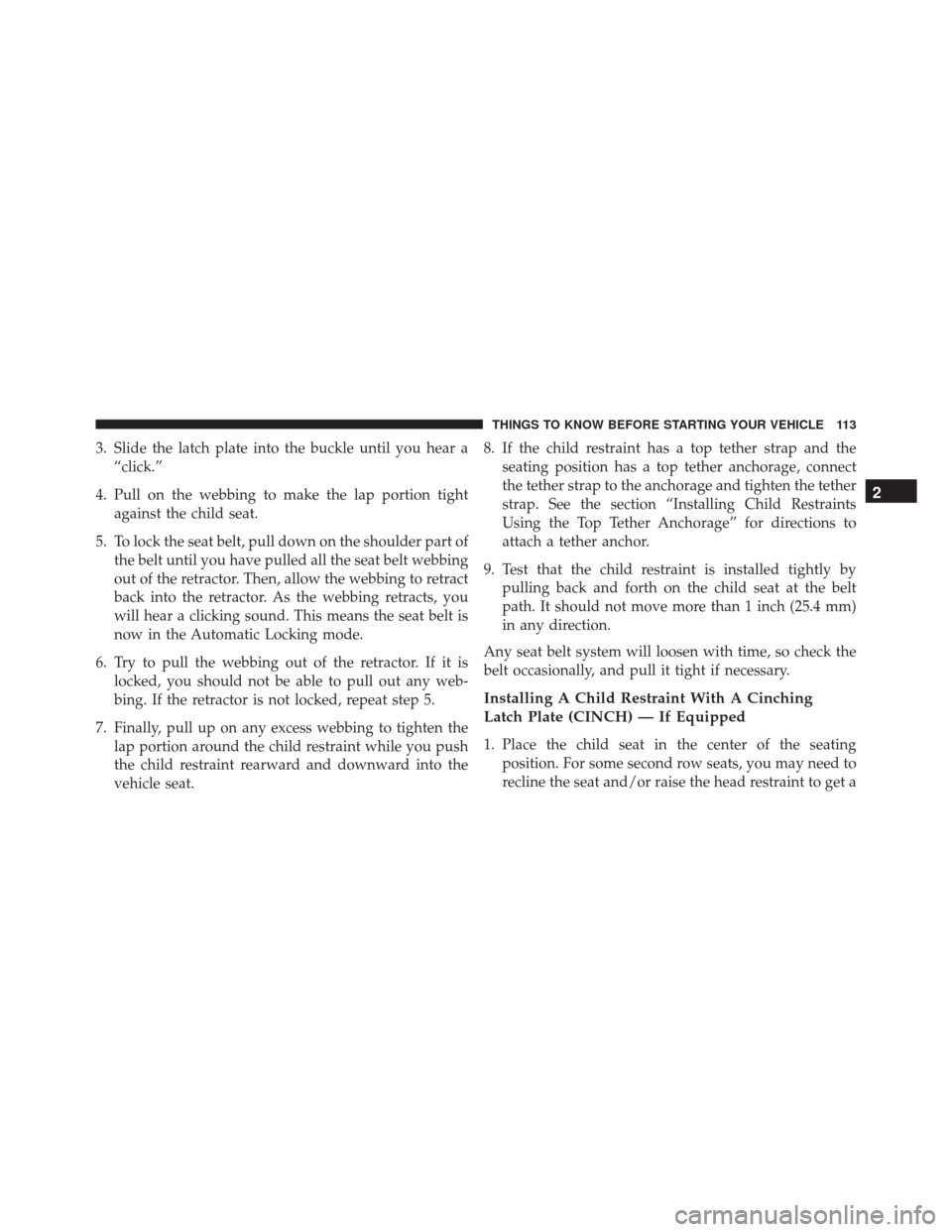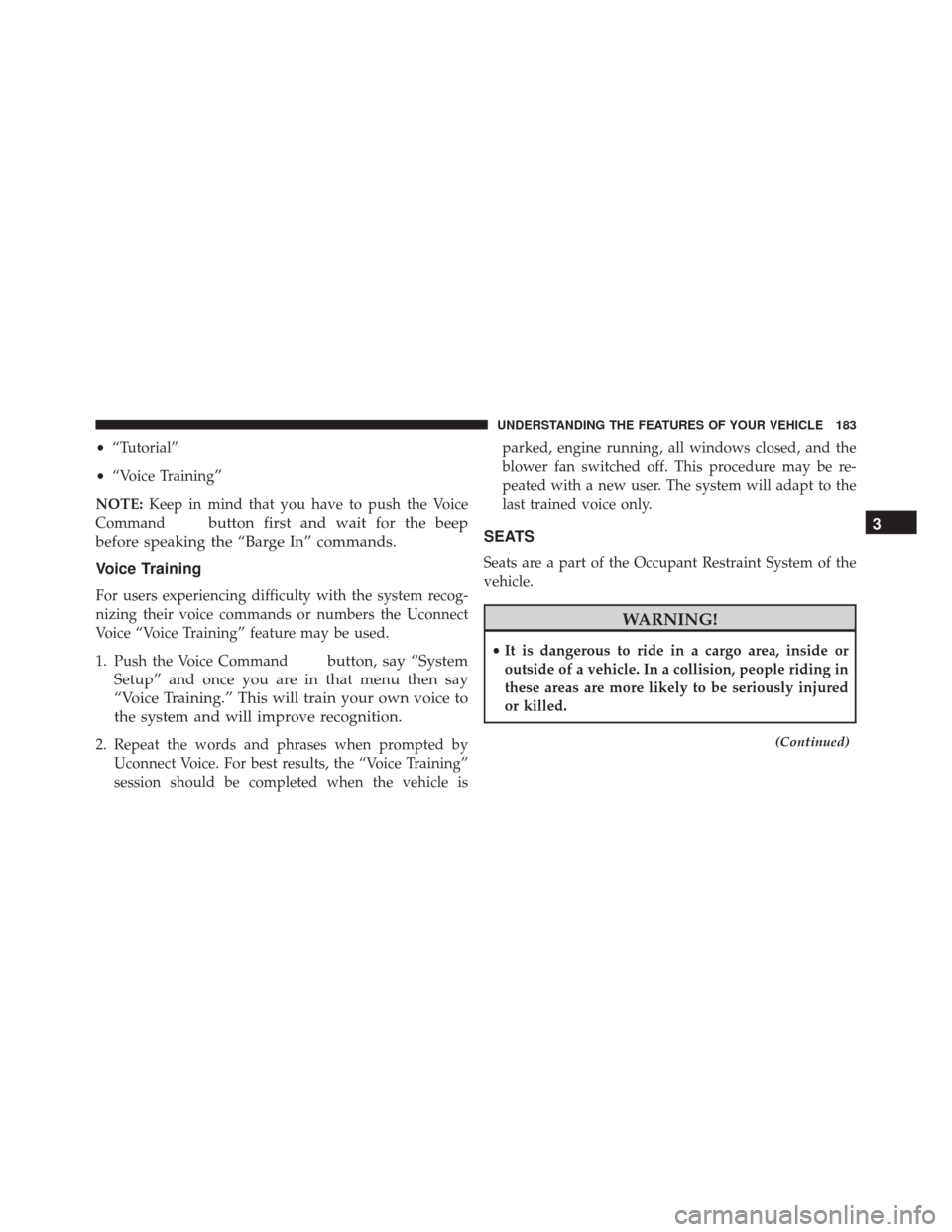Page 106 of 707
Frequently Asked Questions About Installing Child Restraints With LATCH
Can the rear-facing child restraint touch the back of the front passenger seat? Yes
The child seat may touch the back of the
front passenger seat if the child restraint
manufacturer also allows contact. See your child restraint owner ’s manual for more information.
Can the head restraints be removed? YesThe 2nd row head restraints on bench and
fixed quad seats are removable. 2nd row
stow ’n go head restraints are not remov- able. The 3rd row center head restraint is removable in all vehicles.
104 THINGS TO KNOW BEFORE STARTING YOUR VEHICLE
Page 109 of 707

rear-facing child restraints will also be equipped with a
tether strap. The tether strap will have a hook at the end
to attach to the top tether anchorage and a way to tighten
the strap after it is attached to the anchorage.
Center Seat LATCH
If a child restraint installed in the center position blocks
the seat belt webbing or buckle for the outboard position,
do not use that outboard position. If a child seat in the
center position blocks the outboard LATCH anchors or
seat belt, do not install a child seat in that outboard
position.
WARNING!
Never use the same lower anchorage to attach more
than one child restraint. Please refer to “Installing
The LATCH-Compatible Child Restraint System” for
typical installation instructions.Always follow the directions of the child restraint manu-
facturer when installing your child restraint. Not all child
restraint systems will be installed as described here.
To Install A LATCH-Compatible Child Restraint
If the selected seating position has a Switchable Auto-
matic Locking Retractor (ALR) seat belt, stow the seat
belt, following the instructions below. See the section
“Installing Child Restraints Using the Vehicle Seat Belt”
to check what type of seat belt each seating position has.
1. Loosen the adjusters on the lower straps and on the
tether strap of the child seat so that you can more
easily attach the hooks or connectors to the vehicle
anchorages.
2. Place the child seat between the lower anchorages for that seating position. For some second row seats, you
may need to recline the seat and / or raise the head
restraint to get a better fit. If the rear seat can be moved
2
THINGS TO KNOW BEFORE STARTING YOUR VEHICLE 107
Page 114 of 707

Can the head restraints be removed?YesThe 2nd row head restraints on bench
and fixed quad seats are removable.
2nd row stow ’n go head restraints are not removable. The 3rd row center
head restraint is removable in all ve- hicles.
Can the buckle stalk be twisted to
tighten the seat belt against the belt path of the child restraint? Yes
In positions with cinching latch plates
(CINCH), the buckle stalk may be
twisted up to 3 full turns. Do not twist the buckle stalk in a seating position with an ALR retractor.
Installing A Child Restraint With A Switchable
Automatic Locking Retractor (ALR)
1. Place the child seat in the center of the seatingposition. For some second row seats, you may need to
recline the seat and/or raise the head restraint to get a
better fit. If the rear seat can be moved forward and
rearward in the vehicle, you may wish to move it to its rear-most position to make room for the child seat.
You may also move the front seat forward to allow
more room for the child seat.
2. Pull enough of the seat belt webbing from the retractor to pass it through the belt path of the child restraint.
Do not twist the belt webbing in the belt path.
112 THINGS TO KNOW BEFORE STARTING YOUR VEHICLE
Page 115 of 707

3. Slide the latch plate into the buckle until you hear a“click.”
4. Pull on the webbing to make the lap portion tight against the child seat.
5. To lock the seat belt, pull down on the shoulder part of the belt until you have pulled all the seat belt webbing
out of the retractor. Then, allow the webbing to retract
back into the retractor. As the webbing retracts, you
will hear a clicking sound. This means the seat belt is
now in the Automatic Locking mode.
6. Try to pull the webbing out of the retractor. If it is locked, you should not be able to pull out any web-
bing. If the retractor is not locked, repeat step 5.
7. Finally, pull up on any excess webbing to tighten the lap portion around the child restraint while you push
the child restraint rearward and downward into the
vehicle seat. 8. If the child restraint has a top tether strap and the
seating position has a top tether anchorage, connect
the tether strap to the anchorage and tighten the tether
strap. See the section “Installing Child Restraints
Using the Top Tether Anchorage” for directions to
attach a tether anchor.
9. Test that the child restraint is installed tightly by pulling back and forth on the child seat at the belt
path. It should not move more than 1 inch (25.4 mm)
in any direction.
Any seat belt system will loosen with time, so check the
belt occasionally, and pull it tight if necessary.
Installing A Child Restraint With A Cinching
Latch Plate (CINCH) — If Equipped
1. Place the child seat in the center of the seating position. For some second row seats, you may need to
recline the seat and/or raise the head restraint to get a
2
THINGS TO KNOW BEFORE STARTING YOUR VEHICLE 113
Page 121 of 707

SAFETY TIPS
Transporting Passengers
NEVER TRANSPORT PASSENGERS IN THE CARGO
AREA.
WARNING!
•Do not leave children or animals inside parked
vehicles in hot weather. Interior heat build-up may
cause serious injury or death.
• It is extremely dangerous to ride in a cargo area,
inside or outside of a vehicle. In a collision, people
riding in these areas are more likely to be seriously
injured or killed.
•
Do not allow people to ride in any area of your
vehicle that is not equipped with seats and seat belts.
• Be sure everyone in your vehicle is in a seat and
using a seat belt properly.
Exhaust Gas
WARNING!
Exhaust gases can injure or kill. They contain carbon
monoxide (CO), which is colorless and odorless.
Breathing it can make you unconscious and can
eventually poison you. To avoid breathing (CO),
follow these safety tips:
• Do not run the engine in a closed garage or in
confined areas any longer than needed to move
your vehicle in or out of the area.
• If you are required to drive with the trunk/liftgate/
rear doors open, make sure that all windows are
closed and the climate control BLOWER switch is
set at high speed. DO NOT use the recirculation
mode.
(Continued)
2
THINGS TO KNOW BEFORE STARTING YOUR VEHICLE 119
Page 128 of 707

▫Advanced Phone Connectivity ............163
▫ Things You Should Know About Your Uconnect
Phone ............................. .165
▫ General Information ...................177
� VOICE COMMAND — IF EQUIPPED ........177
▫ Voice Command System Operation .........177
▫ Commands ........................ .179
▫ Voice Training ...................... .183
� SEATS ............................. .183
▫ Power Seats — If Equipped ..............184
▫ Power Lumbar — If Equipped ............187
▫ Heated Seats — If Equipped ..............187
▫ Manual Front/Second Row Seat Adjuster . . . .191 ▫
Manual Reclining Seats — If Equipped ......192
▫ Head Restraints ..................... .193
▫ Stow ’n Go Seating — If Equipped .........197
▫ Quad Seats — If Equipped ...............204
▫ Second Row Bench Seat — If Equipped ......208
▫ Third Row Power Recline — If Equipped .....209
▫
Third Row Power Folding Seat — If Equipped . .210
▫ Manually Folding Third Row Seats — If
Equipped .......................... .212
▫ Plastic Grocery Bag Retainer Hooks .........215
� DRIVER MEMORY SEAT — IF EQUIPPED .....216
▫ Programming The Memory Feature .........217
▫ Linking And Unlinking The Remote Keyless Entry
Transmitter To Memory .................217
126 UNDERSTANDING THE FEATURES OF YOUR VEHICLE
Page 185 of 707

•“Tutorial”
• “Voice Training”
NOTE: Keep in mind that you have to push the Voice
Command
button first and wait for the beep
before speaking the “Barge In” commands.
Voice Training
For users experiencing difficulty with the system recog-
nizing their voice commands or numbers the Uconnect
Voice “Voice Training” feature may be used.
1. Push the Voice Command
button, say “System
Setup” and once you are in that menu then say
“Voice Training.” This will train your own voice to
the system and will improve recognition.
2. Repeat the words and phrases when prompted by Uconnect Voice. For best results, the “Voice Training”
session should be completed when the vehicle is parked, engine running, all windows closed, and the
blower fan switched off. This procedure may be re-
peated with a new user. The system will adapt to the
last trained voice only.
SEATS
Seats are a part of the Occupant Restraint System of the
vehicle.
WARNING!
•
It is dangerous to ride in a cargo area, inside or
outside of a vehicle. In a collision, people riding in
these areas are more likely to be seriously injured
or killed.
(Continued)
3
UNDERSTANDING THE FEATURES OF YOUR VEHICLE 183
Page 186 of 707
WARNING!(Continued)
•Do not allow people to ride in any area of your
vehicle that is not equipped with seats and seat
belts. In a collision, people riding in these areas are
more likely to be seriously injured or killed.
• Be sure everyone in your vehicle is in a seat and
using a seat belt properly.
Power Seats — If Equipped
Some models may be equipped with eight-way power
seats for the driver and front passenger. The power seat
switches are located on the outboard side of the seat. The
switches control the movement of the seat cushion and
the seatback.
Driver Power Seat Switch
1 — Seat Switch 2 — Seatback Switch
184 UNDERSTANDING THE FEATURES OF YOUR VEHICLE